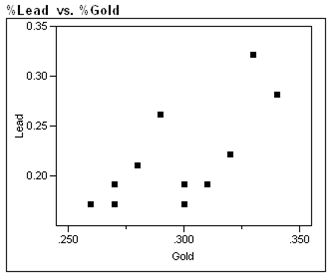Exhibit 5-5
During the first 3 centuries AD, the Roman Empire produced coins in the Eastern provinces. Some historians argue that not all these coins were produced in local mints, and further that the mint of Rome struck some of them. Because the "style" of coins is difficult to analyze, the historians would like to use metallurgical analysis as one tool to identify the source mints of these coins. Investigators studied 11 coins known to have been produced by local mints in an attempt to identify a trace element profile for these coins, and have identified gold and lead as possible factors in identifying other coins as having been locally minted. The gold and lead content, measured as a % of weight of each coin, is given in the table, and a scatter plot of these data is presented below.

-Suppose that the locally minted coins analyzed in Exhibit 5-5 are representative of the metallurgical content of mints in the Eastern provinces of the Roman Empire during the first 300 years AD.
a) If a locally minted coin is selected at random, and it's gold content is 0.30% by weight, calculate the predicted lead content. Be sure to use correct notation and units.
b) One of the coins used to calculate the regression equations has a gold content of 0.300%. Calculate the residual for this coin. Be sure to use correct notation and units.
c) The investigators would like to use the regression equation to help assess whether a coin is locally minted or minted in Rome. In a few sentences, describe how the regression equation could be used for this purpose. (Hint: In order to use the equation for this purpose, how would coins minted in Rome have to differ from locally minted coins?)
Definitions:
Misleading Information
False or inaccurate information that is presented in a way that deceives or misguides the audience.
Product Placement
A marketing strategy where branded products are placed in the context of media content, such as movies or TV shows, without explicit advertisement.
Market Anomalies
Instances where financial markets deviate from the expected or normal behavior, often leading to unexpected investment opportunities.
Advertising
The activity or profession of producing advertisements for commercial products or services, aiming to influence the buying behavior of consumers.
Q6: As n grows larger, the mean of
Q6: Nutritionists study the impact of four different
Q7: One of the early decisions that must
Q10: Viruses are infectious agents that often cause
Q21: _ are largely outside of the direct
Q29: For a discrete random variable, <img src="https://d2lvgg3v3hfg70.cloudfront.net/TB7678/.jpg"
Q56: The existence of divergent objectives between owners
Q60: Which of the following is an example
Q64: The_ method is used to display a
Q73: The DropDownStyle property of a combo box